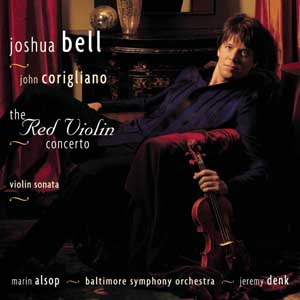 John Corigliano is widely considered one of the leading American composers of his generation, which includes such luminaries as Morten Lauridsen, Terry Riley, and Ned Rorem. Commentators have characterized his style as “highly expressive,” “compelling,” and “kaleidoscopic.” In addition to symphonies, chamber works, and opera, Corigliano has also done film scores.
John Corigliano is widely considered one of the leading American composers of his generation, which includes such luminaries as Morten Lauridsen, Terry Riley, and Ned Rorem. Commentators have characterized his style as “highly expressive,” “compelling,” and “kaleidoscopic.” In addition to symphonies, chamber works, and opera, Corigliano has also done film scores.
In 1996-97 he wrote the score for The Red Violin, a film by Françis Giraud about the 300-year history of a violin and the lives of those who encounter it. The Red Violin Chaconne, an independent concert work, was developed from the score, and Corigliano went on to use the Chaconne as the basis for the full concerto, premiered in 2003.
Corigliano admits quite readily to a particular attachment for the violin. His father was a concert violinist and the concertmaster of the New York Philharmonic for more than 25 years, and Corigliano grew up with snatches of the great works from the violin repertoire as the soundtrack of his own life.
The Concerto is, indeed, kaleidoscopic: Corigliano keeps doing things that you somehow suspect that he shouldn’t be allowed to do, beginning within a few bars of the opening, which is suitably moody and includes some beautiful writing for the soloist. The first movement is a study in contrasts, incomparably sweet solo passages punctuated by orchestral interruptions with all the requisite angst of twentieth-century music. Although the work is in four movements, it is such a volatile, restless piece of music that it’s difficult to separate them — it becomes more a matter of slight shifts in temperament than of being able to say “in the slow movement. . . ,” except of course, now that I’ve written that, there really is a slow movement, “Adante flautando,” which offers a substantial and quite serene interlude, which in turn is abruptly broken by the beginning of the final movement, the “Accelerando finale.” I should note that, while there are occasional phrases that might tempt one to think “film score,” there is really very little to indicate that any of this music ever had a separate existence: it is that much an organic whole.
The Sonata for Violin and Piano (1963) is an early work; in 1964, when the composer was 26, it won the first chamber music competition at the Spoleto Festival. It displays all the mutability of the Concerto, although tonally it is less adventurous. As Corigliano notes, it is definitely a work by an American composer, although I’m hard put to describe exactly what that means. (If you doubt me, take a look at those I enumerated above as belonging roughly to Corigliano’s generation; if you are at all familiar with their music, you will understand what I’m up against here.) It also displays Corigliano’s deep sympathy for the violin, and his ability to make the most of its sonic resources. I might also note that, unlike many sonatas in which a solo instrument is featured and the accompanist is usually unobtrusive to the point of nonexistence, Corigliano has allowed the piano full play here, making it a full partner in the enterprise.
Joshua Bell has a long history with Corigliano’s Red Violin: he recorded the original soundtrack, premiered the Chaconne with the San Francisco Symphony, and went on to premiere the Concerto with the Baltimore Symphony. Jeremy Dent is a strong colleague in the Sonata, as are Marin Alsop and the Baltimore Symphony in the Concerto. To my ear, all the participants in this recording have a solid understanding of Corigliano’s music and the technical ability to keep up with his demands. (Purely as an aside, it is a wonder and a delight to me that there are so many smaller orchestras and younger performers who are undertaking the performance of contemporary music. It is, after all, the music of our time, and deserves the exposure.)
I’m not sure I’m as blown away by this recording as I have been by those of other contemporary composers — there’s always a major subjective element in that kind of reaction — but it’s easy to see why Corigliano has gained the reputation he has: there is something quintessentially American about these works, and something that is very much of the late twentieth century. After all, the composers we remember are those who speak with the voice of their time and place and bridge the gap between then and now. In Corigliano’s case, he’s taken it one step further: the music is right here, right now, and he’s reminded us that that’s a time and place those of us devoted to “high culture” too often forget.
(Sony BMG Music Entertainment, 2007)
